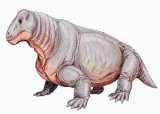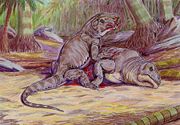
Ulemosaurus
Encyclopedia
Ulemosaurus svijagensis was a dinocephalia
n synapsid
that lived 250 million years ago, at Isheevo in Russia
n Tatarstan
.

 Only several partial skeletons and skulls have been found. The skull bones are extremely dense: about 10 cm at its thickest. This thickening is possibly related to head-butting behavior, as some researchers suggest. The species is considered a herbivore
Only several partial skeletons and skulls have been found. The skull bones are extremely dense: about 10 cm at its thickest. This thickening is possibly related to head-butting behavior, as some researchers suggest. The species is considered a herbivore
, but because the mandible
is heavily constructed some palaeontologists consider it a carnivore
, with the species being able to use muscle power to cut prey up with its incisor
s.
Ulemosaurus was closely related to Moschops
. Both were tapinocephalids, a group of bulky herbivores which flourished in the Middle Permian. Ulemosaurus and other tapinocephalians disappeared at the end of the Mid-Permian.
Dinocephalia
Dinocephalia are a clade of large early therapsids that flourished during the Middle Permian, but became extinct leaving no descendants.-Description:...
n synapsid
Synapsid
Synapsids are a group of animals that includes mammals and everything more closely related to mammals than to other living amniotes. They are easily separated from other amniotes by having an opening low in the skull roof behind each eye, leaving a bony arch beneath each, accounting for their name...
that lived 250 million years ago, at Isheevo in Russia
Russia
Russia or , officially known as both Russia and the Russian Federation , is a country in northern Eurasia. It is a federal semi-presidential republic, comprising 83 federal subjects...
n Tatarstan
Tatarstan
The Republic of Tatarstan is a federal subject of Russia located in the Volga Federal District. Its capital is the city of Kazan, which is one of Russia's largest and most prosperous cities. The republic borders with Kirov, Ulyanovsk, Samara, and Orenburg Oblasts, and with the Mari El, Udmurt,...
.


Herbivore
Herbivores are organisms that are anatomically and physiologically adapted to eat plant-based foods. Herbivory is a form of consumption in which an organism principally eats autotrophs such as plants, algae and photosynthesizing bacteria. More generally, organisms that feed on autotrophs in...
, but because the mandible
Mandible
The mandible pronunciation or inferior maxillary bone forms the lower jaw and holds the lower teeth in place...
is heavily constructed some palaeontologists consider it a carnivore
Carnivore
A carnivore meaning 'meat eater' is an organism that derives its energy and nutrient requirements from a diet consisting mainly or exclusively of animal tissue, whether through predation or scavenging...
, with the species being able to use muscle power to cut prey up with its incisor
Incisor
Incisors are the first kind of tooth in heterodont mammals. They are located in the premaxilla above and mandible below.-Function:...
s.
Ulemosaurus was closely related to Moschops
Moschops
Moschops is an extinct genus of therapsid that lived in the Late Permian, around 255 million years ago. Therapsids were proto-mammals , which were the dominant land animals. Five metres long, Moschops was the largest land animal of its time, a herbivore preyed on by other therapsids...
. Both were tapinocephalids, a group of bulky herbivores which flourished in the Middle Permian. Ulemosaurus and other tapinocephalians disappeared at the end of the Mid-Permian.

